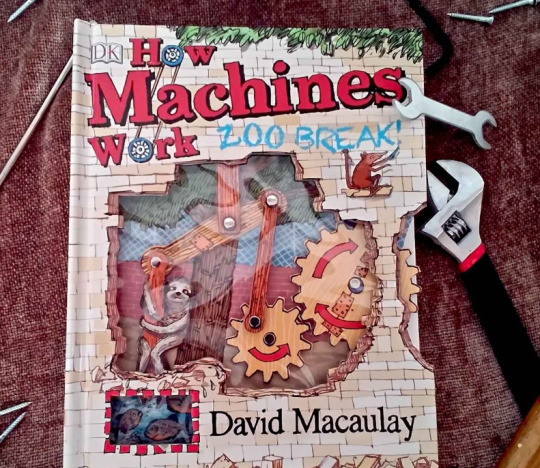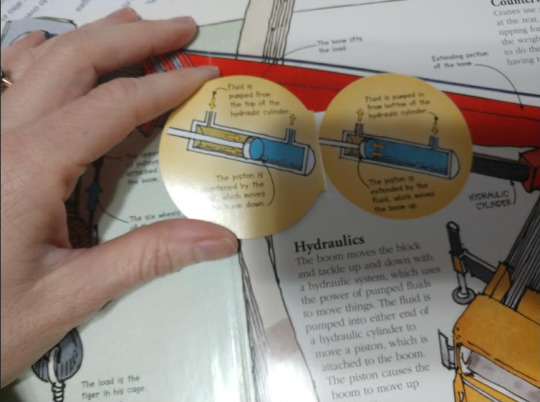#physicsforkids
Explore tagged Tumblr posts
Video
youtube
Is time travel possible?
#youtube#Physics Science LearnPhysics PhysicsFun PhysicsExperiments GeniusInMotion PhysicsIsBeautiful STEM PhysicsEducation PhysicsForKids CuriousAbo
0 notes
Text
Work with Simple Machines

Photo from Winkbooks.net
DK How Machines Work: Zoo Break
Written and Illustrated by David Macauley
Published by Penguin Random House
2015
Won the Royal Society’s Young People’s Book Prize
American Institute of Physics Science Writing Award for Writing for Children (2016)
Meet Sloth and Sengi, two zoo animals who are bored with captivity. In this ingenious introduction to simple machines, kids can use pop up components to conduct hands-on-experiments and engage in scientific inquiry while they help the main characters escape.
The characters in the story experiment with creating different devices to free themselves, first trying to wedge open a door, then trying to get over the fence with a lever and even later, building a flying machine! This problem and solution structure is enhanced by the hands-on attributes and allows children to extrapolate, asking questions and running their own experiments with Sengi and Sloth.
This book is directed toward children in grades 2-5. That is about right. The introduction of the manipulative elements will attract children in the younger grades who need a kinesthetic experience in order to grasp how these machines work. Here, readers can use a pop-out plank and a pop-up fulcrum to build a simple lever and pop Sengi and Sloth over the fence.

Photo courtesy of Amazon.com
And the American Institute of Physics reported that “Readers interact with the characters and the different types of simple machines. We especially liked the pop-up and removable interactive components in this book, which can be used to introduce children to basic physics and engineering principles or to introduce inquiry science lessons involving simple machines.”
This interactive narrative non-fiction picture book meets the criteria for non-fiction in the way only David Macauley can. The organizational structure is simple and easy to navigate. Big headings in the top corners of each page like “Inclined to Escape” on page 4 introduces scientific vocabulary children need to know. The heading is followed by expository text and the language is sophisticated, geared toward the older readers in grades 4-6.
“An inclined plane is essentially a sloped surface. It makes climbing easier by making the climb less steep. Even though the distance is increased, the effort needed is much less.”
A full-bleed glossary is included on pages 28-29 in case readers need clarification about these terms.
While the language and the story are a key component for the reader it is the pictures and layout that really make this book effective for a wide variety of readers. Information is delivered in small chunks across richly illustrated pages. Small circles and squares are set out from the text and contain illustrations that offer close up details for the reader to analyze such as on page 20 when the concept of a screw is explained in words and pictures. An oval inset shows how to wrap a length of hose around a stick, taking advantage of the qualities of the inclined plane to make an Archimedes Screw that moves water. The simple illustration makes the complicated concept clearer.
The illustrations are whimsical, with lots of little lines to demonstrate detail and movement and a muted palette of colors, greens and greys and browns that keep the busy pages from becoming overwhelming.

Photo: Hadley Roberts, (2019)
The other reason I love this book is the subtle payoff kids get from lifting flaps and digging deeper into the content. On the page about the Archimedes screw, the name Archimedes is only found by lifting up a flap that looks like Sloth. Inside a fold-out explains how screw pumps have been found throughout history, designed by Archimedes but also possibly found in Babylon.
On the page before a similar flap uses tiny pictures to explain exactly how fluid functions in a hydraulic pump.

The simple text reads “Fluid is pumped from the top of the hydraulic cylinder. The piston is shortened by the fluid which moves the boom down.” Arrows guide the reader through the process, offering further visual clues, even though the language is fairly simple and the glossary exists to clear up the more complex terms.
Yet another booklet explains gears. And in this one, a subtle background of graph paper lends a feel of authority and a dash of the engineering environment to the concept.
But the characters of Sloth and Sengi lend whimsy and fun to the serious concepts. Sight gags like Sloth explaining that he’s “not cut out for this” while he is pictured sawing a board adds age-appropriate humor to the mix.
The characters are pretty flat, They have simple personalities. Sengi is the brainy one who always innovates and Sloth is the funny, one but this is done intentionally so that the reader doesn’t get too wrapped up in the narrative and instead focuses on the machines and their own interactive role in the story.
The book culminates with Sengi masterminding a major build, a complex machine that combines all the elements discussed throughout the book. The foldout drawing of Sengi’s machine is enormous, About two feet by one and a half feet. It uses numbered arrows to direct the reader and though it lacks text this encourages the reader to think carefully about each aspect of this giant device.
This book would be a great addition to a center in a classroom and could be further enhanced with the edition of a table full of objects, Keva planks, twine, pulleys, cardboard and pegs, sticks, and Lincoln logs that could be used to extend the play this book encourages.
Books to pair with this include:

Gizmos and Gadgets: Creating Science Contraptions That Work (And Knowing Why)
by Jill Frankel Hauser
Williamson Books, Nashville Tennessee
1999
This is an older book but science never goes out of style. An activity book with instructions for 50 working contraptions to play with. I love this book because it uses simple everyday objects to explain science concepts, like on page 32 “You can learn a lot about friction by exploring the soles of footgear. Check out these shoes and think about their uses: basketball shoes, hiking shoes, cleated shoes for baseball and soccer, ballet slippers, rain boots, and skates.”
The black and white illustrations are simple and easy to follow. An index and back matter suggest more books to turn to for ideas.
Cao Chong Weighs an Elephant
By Songju Ma Daemicke
Illustrated by Christina Wald
Best STEM Books of 2018 for K-12 Selection by NSTA, ITEEA & CBC Outstanding Science Trade Books Selection of 2018 by NSTA & CBC Notable-Social-Studies books of 2018 selection by NCSS &CBC A Mathical Honor Books of 2018 by MSRI, NCTM & CBC< Children's Book Council "Book Power" Showcase selection

This book tells the classic Chinese tale of a child prodigy and his unique solution to a scientific problem.

The Frank Einstein Series
Author: John Scieszka
Illustrator: Brian Biggs
Publisher: Penguin Random House
Science-tinged fiction for the 7-10 set
Kid inventor Frank Einstein and his two robots, Klink and Klank mix science, adventure, and slapstick into this entertaining set of six books.
For older kids who are exploring these concepts this YA biographical fiction about Archimedes sounds like a snorer. but it is really not!The Sand Reckoner by Gillian Bradshaw is worth a look! I read for two days straight and couldn’t put it down.

0 notes
Video
instagram
My future dream play room is going to have a ginormous metal wall like this - we will have so much magnetic fun! For now we will just play with the libraries and pretend it's ours ❤ #problemsolving #makinghimthink #magneticfun #libraryday #physicsforkids #forceandmotion #kidengineer #stemed #steam #earlylearning #handsonlearning #playtolearn #dreamplayroom #futurehouse #housegoals #discoveryzone #childhoodunplugged (at St. Louis County Library (Florissant Valley))
#stemed#discoveryzone#forceandmotion#physicsforkids#makinghimthink#steam#housegoals#problemsolving#dreamplayroom#childhoodunplugged#kidengineer#earlylearning#magneticfun#handsonlearning#futurehouse#libraryday#playtolearn
0 notes